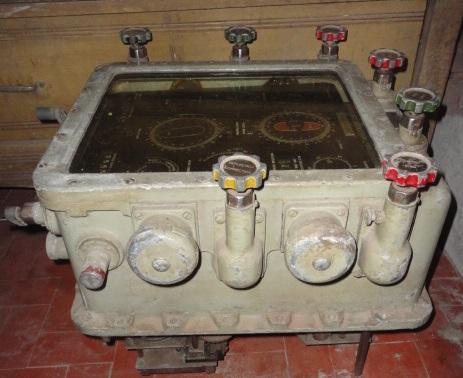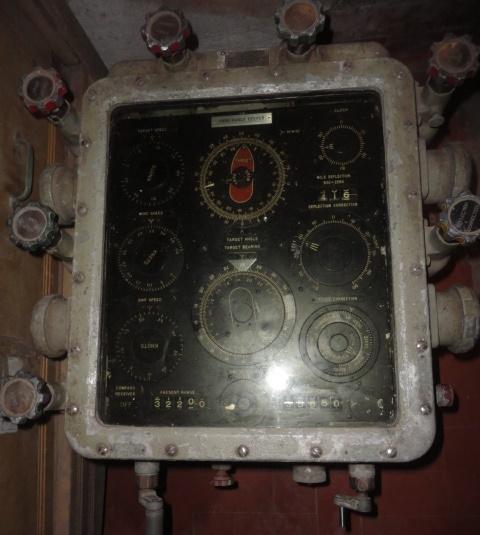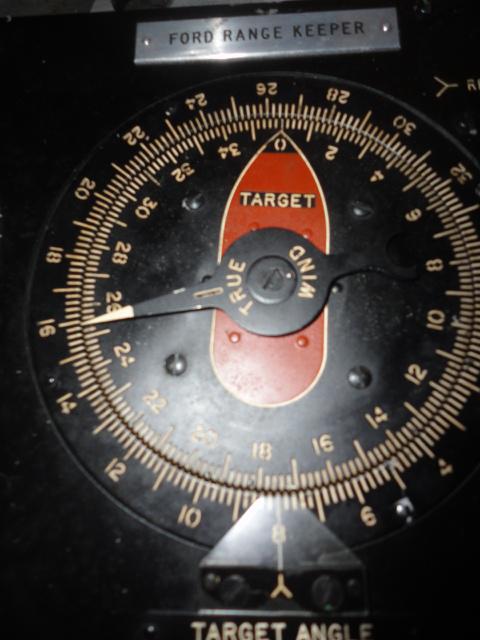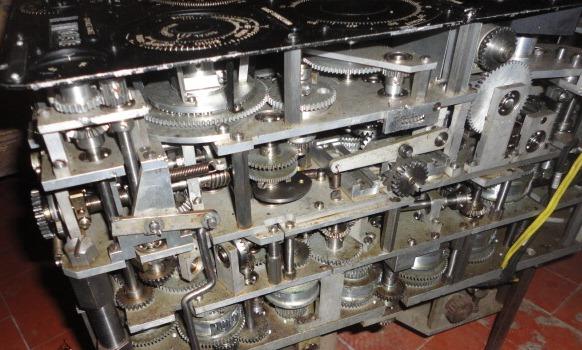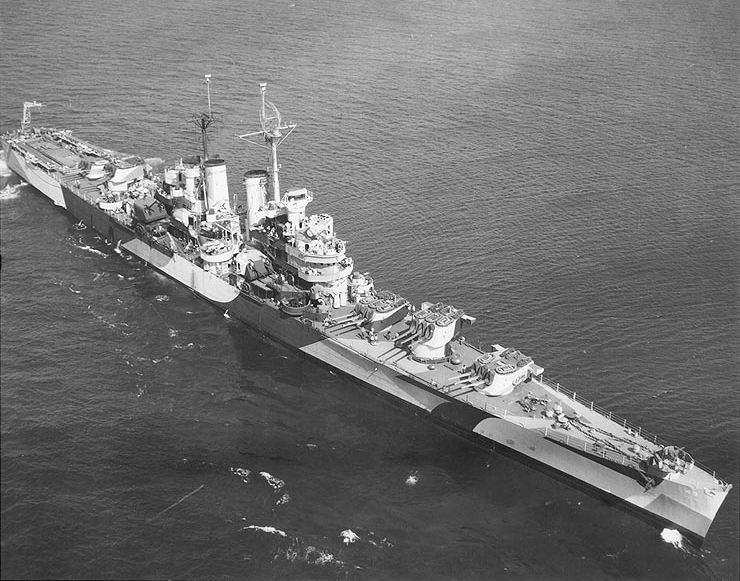 |
We are brick & mortar now!!
Visit us in Parkesburg, PA For more info: www.TheComputerChurch.org (This site no longer maintained.) |
YEAR: 1930
COMPANY: Ford Instrument Company, Inc.
COUNTRY: USA
IN OUR COLLECTION: Yes
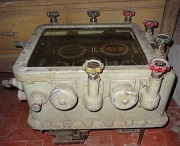
This electro-mechanical computer was used on the USS St. Louis (CL-49) to provide firing solutions and control the big guns (6") on the St. Louis. The St. Louis (AKA the "Lucky Lou") was the first ship to make it out of Pearl Harbor on the morning of December 7, 1941.
The metal label attached to this item identifies the type of guns that were controlled by this computer, the time of flight cam gear, and the manufacturer. The Date, Inspector, Weight, and Serial number are not filled in. The Mark 7 version seems to be the first one that is designated as a Range Keeper rather than a computer. The label is somewhat difficult to read but you should make out the following:
U.S. NAVY BUREAU OF ORDNANCE
Range Keeper Mk. 7 Mod. 16
6" 47 Cal. 1/25 Twist Rifling
130 Lb. A.P. 2425 F.S.I.V.O.D. 3725
105 Lb. H.C. 2590 F.S.I.V.O.P. 933
DATE |_________| Inspector |________|
Wt. |____| Lbs. Serial No. |________|
FORD INSTRUMENT CO. INC.
Long Island City, N.Y.
This computer used both electric inputs and hand-operated inputs (mechanical). Radar information was fed directly into the computer by electric wiring. However, a large number of important inputs had to be set up by hand, generally by turning knobs or handles that would, in turn, move gears within the computer. For instance, the Mark 7 had seven knobs (Wind Speed, Ship Speed, Target Speed, Target Angle, Wind Angle, True Bearing, Deflection Correction), and turning each one would set the internal gears so that a firing solution could be computed. The settings could be monitored by the operator simply by looking at a series of dials on the computer display. (The operator stood and looked down through a glass top, beneath which were the current settings for the computer.) There were also handles that needed to be set.
The earliest Range Keepers (first deployed in 1916 during WWI) provided a firing solution, but the sailors had to aim the big guns to the correct settings provided by the computer. However, sailors often became fatigued in battle and didn't move the guns to the correct settings. This 1936 Range Keeper sent the firing solutions directly to the big guns (electrically, by controlling servo-motors that aimed the guns).
We have tentatively dated this computer to 1936 while we complete our research. The National Museum of the United States Navy in Washington, DC has informed us that they do not have any records that allow them to track the serial number of the computer. They pointed out that so many ships were being built in the mid and late 1930's that the Navy didn't have time to track individual parts of a ship. The "Lucky Lou" was launched in 1938 and its keel was laid in 1936. We have dated the computer to 1936 with the assumption that it was ordered as that ship was being built.
We hope that the images of this computer provide you with a new perspective on computing and an appreciation for the ingenuity of those men and women who developed this computer. We are used to seeing computer boards and wires in a computer...but to realize that the decision-making (firing solution) was done by gears is really quite amazing.
This is not the entire Range Keeper. Parts of it were too heavy to remove from the ship and were lost when the ship sank in heavy seas while it was being towed to a salvage dock in 1980. This section alone weighs over 200 pounds.
We have a Navy manual for the Mark 7 with inspection documents that show that this computer was being used as early as 1930. It's entirely possible that the Mark 7 was first manufactured in the late 1920s. The model we have (Model 16) in our collection was likely made in 1936.
Related Item 2: Fire Control Equipment: Range Keeper Mark VII
Related Item 3: Time of Flight Clock
Related Item 4: Fire Control Technician 3
|
Copyright © 2025 by Early Computers Project, All Rights Reserved. |
(Analogs in blue)
- AIM-65 (single board)
- AIM-65 (factory case)
- AIM-65 (Jon Titus)
- ALICE micro-ordinateur
- Altair 680
- Altair 8800
- Altair 8800A
- Altair 8800b
- Altair 8800b Turnkey (see Pertec below)
- Altair 8800b (see Pertec below)
- Altair 8800b w/ Hardisk Controller & Datakeeper
- Altos ACS-8000
- American Basic Science Club Analog Computer
- AMF Educational Computer
- Apple II Plus
- ASCI SystemX
- ASR 33 Teletype
- Automatic Teaching Computer Kit
- Beckman ElectroComp Electric Heating Computer
- Beckman ElectroComp Energy Savings Computer
- Beckman Solid State Fuel Cost Computer
- Brainiac K-30
- Calif. Computer Systems 2200
- CES Ed-Lab 650
- Commodore 8032
- Commodore 64
- Commodore PET 2001
- Commodore Super Pet
- Compucolor II
- Compukit 1
- Compukit 1 Deluxe Model
- Compukit 2
- Compukit UK101
- Comspace CT-650
- Cosmac Elf (RCA1802)
- Cosmac Microtutor
- Cosmac Netronics ELF II
- Cosmac VIP
- Cromemco System I
- Cromemco System III
- Cromemco Z-2D
- Datapoint 2200
- Digi-Comp I (flat box)
- Digi-Comp I (square box)
- Digital Computer Lab
- Donner 3500
- Durango F-85
- Dynabyte
- E & L Inst MMD-1
- E & L Inst MMD-2
- Eagle II
- Electric Tabulating Machine (one original counter, 1889)
- Electronic Associates TR-10
- Electronic Associates TR-10 Model II
- Electronic Associates TR-20
- Electronic Associates TR-48
- Electronic Associates Model 180
- Electronic Associates Model 380 Hybrid
- Geniac
- Google Glass (definitely not vintage)
- Heath EC-1 (factory assembled by Heath)
- Heathkit EC-1 (kit)
- Heathkit ET 3100 trainer
- Heathkit H8
- Heathkit H9 Video Terminal
- Hickok Logic Teaching Sys.
- Hickok Servo Teaching Sys.
- HP 2115A
- HP 85
- HP 5036A
- HP 9825A
- HP 9825B
- HP 9830A
- Iasis 7301
- I-COR MAC-1
- ICS Microcomputer Training System
- IMSAI 108 (prototype)
- IMSAI 8048 Control Computer
- IMSAI 8048 (The Dollhouse Computer)
- IMSAI 8080
- IMSAI PCS-40
- IMSAI PCS-80
- IMSAI VDP-80
- Informer
- Intel Intellec MDS
- Intel MDS-800
- Intel Prompt 48
- Intel SBC 80/10
- Intel SDK-85
- Intel SDK-85 (unassembled)
- Intel SDK-86
- Intertec Superbrain
- ITT MP-EX
- JR-01 Computer
- KIM-1
- LAN-DEC
- LAN-DEC 20
- LAN-ALOG
- Lehrcomputer (Germany)
- Lawrence Livermore Lab
- Lear Siegler ADM3A
- Logikit LK255 (Feedback)
- Logix SF-5000 Electronic Computer
- MAC-1 Mini Analog Computer
- MAC Tutor (Bell Laboratories)
- MEK6800D2
- Micro 68
- Microtan 65
- Midwest Scientific Instruments 6800
- Minivac 601
- Minivac 6010
- Mini-Scamp Microcomputer
- Nascom I
- Nascom II
- National Radio Institute 832
- NEC TK-80
- NorthStar Horizon
- Olivetti Programma 101
- Olivetti Programma 203
- Olivetti Programma 602
- Open University PT501
- Ordinateur d'Apprentissage JR-01
- Osborne 1
- OSI 300
- OSI 600 (SuperBoard II)
- OSI C2-OEM-4
- OSI Challenger-1P
- Pastoriza Personal Analogue Computer
- Pertec MITS 300/25 (Altair desk business system)
- Pertec MITS 300/55 (Altair Turnkey business system)
- PolyMorphic Systems 8810
- PolyMorphic Poly-88
- Protech-83
- Range Keeper Mk.6 Mechanical Analog Computer, 1926
- Range Keeper Mk.7 Mechanical Analog Computer, 1935?
- Sargent-Welch Scientific Company Cat. No.7528 Analog Computer
- Science of Cambridge MK-14 (Sinclair)
- SD Systems Z80 starter kit
- Sharp MZ-40K
- Sharp MZ-80k
- Siemens ECB-85
- Signetics Instructor 50
- Sinclair ZX-81
- Smoke Signal Broadcasting
- Sol-20
- Spark16
- Sphere 1
- Sphere/SWTPC Computer System
- SWTP CMOS Microlab
- SWTP CT-82 Terminal
- SWTPC 6800
- SWTPC 6800 (w/ Smoke Signal Broadcasting drive)
- SWTPC CT-64 Video Terminal, SS-50
- SWTPC TV Typewriter II CT-1024
- Synertek VIM-1
- Synertek SYM-1
- Systron-Donner 3500
- Tei MCS-112
- Tektronix 4006-1
- Telefunken RAT 700
- TI LCM-1001 (Microprogrammer)
- TI LCM-1001 (Microprogrammer)
- TI Silent 700 Terminal
- TI TM 990/189
- Vector 1
- Vector 3
- Vidac 336
- Wang 2200
- Welch Scientific Company Cat. No.7528 Analog Computer
- Xerox 820 Mark I
- Chameleon Plus
- Commodore SX64
- Epson HX-20
- Kaypro I
- Kaypro II
- Kaypro 2x
- Kaypro 16
- Osborne 1
- Panasonic Senior Partner
- Visual Commuter
- Babbage's Calculating Engine (1834)
- Electric Tabulating Machine (1889, Herman Hollerith's personal copy)
- The Hollerith Electric Tabulating System (1890)
- Counting a Nation by Electricity (1891)
- Calculating Machines (1947)
- Moore School Lectures Vol. II (1947)
- Mathematical Theory of Communication (1948)
- Communication Theory of Secrecy Systems (1949)
- The "Moore's Law" article (Electronics, 1965)
- Printout from Babbage's Difference Engine #2 (London Science Museum, 2004)
